Trend Micro Bundle
Can Trend Micro Conquer the Future of Cybersecurity?
Trend Micro, a titan in the cybersecurity arena, has consistently demonstrated its ability to adapt and thrive. From its inception in 1988, the company has evolved from antivirus software to a comprehensive cybersecurity platform. This exploration delves into Trend Micro's Trend Micro SWOT Analysis, growth strategy, and future prospects, offering a glimpse into its strategic initiatives.
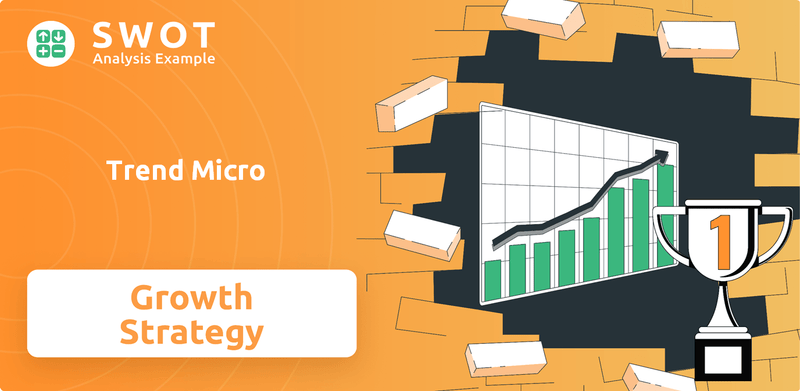
This analysis will examine Trend Micro's market share analysis, financial performance, and competitive landscape within the IT security solutions sector. We'll explore its cloud security strategy, endpoint security solutions, and threat intelligence capabilities, alongside its partnerships, research and development investments, and expansion plans. Ultimately, we aim to provide a data-driven assessment of the Trend Micro company's trajectory and its impact on the cybersecurity industry.
How Is Trend Micro Expanding Its Reach?
The expansion initiatives of Trend Micro are strategically designed to capitalize on the evolving cybersecurity landscape. The company's primary focus is on platform consolidation and leveraging AI-powered solutions. This approach aims to meet the increasing demands of businesses for comprehensive and unified security, which is a key aspect of its overall Trend Micro growth strategy.
A central component of Trend Micro's strategy is the Trend Vision One platform. This platform is designed to provide a unified security solution, reducing the need for multiple siloed tools. The company's efforts to increase the adoption of this platform are a critical part of its expansion plans. Furthermore, the company is actively exploring new business models and potential mergers and acquisitions to strengthen its market position and enhance its Trend Micro future prospects.
The company's expansion is also influenced by its geographical performance and product category focus. These initiatives are supported by strategic partnerships and a shift towards subscription-based models. These different elements are all integrated to drive growth and maintain a competitive edge in the cybersecurity market.
Trend Micro is focused on increasing the adoption of its Trend Vision One platform. This platform is central to its strategy, aiming to provide a comprehensive and unified security solution. In Q1 2025, the platform saw a 14% growth in large enterprise Annual Recurring Revenue (ARR).
Europe showed the highest growth at 4.3% in Q1 2025, while the Americas experienced a slight decline. The company aims to accelerate performance across all regions. The company is focused on expanding its reach and adapting to regional market dynamics.
Endpoint security remains a significant segment, contributing over 30% of its 2023 revenue of $1.63 billion. Trend Micro is also seeing strong performance in the cloud-native application protection platform (CNAPP) space, where it held a 13.1% market share in 2023. This highlights the company's diversification efforts.
Over 100 new strategic managed service providers joined in Q1 2025. This contributed to a 4x increase in ARR per customer for small enterprises adopting cyber risk exposure management solutions. These partnerships are crucial for expanding market reach.
Trend Micro is also exploring new business models, such as transacting through Azure and Google Cloud Platform marketplaces, following success with AWS marketplace. This shift towards a subscription-based model is designed to provide more flexible and scalable solutions for its customers. Potential mergers and acquisitions are also on the table, with reports indicating interest from private equity firms to take the company private. This could involve merging core products with other capabilities to re-emerge as a larger competitor. For more detailed analysis on the competitive landscape, you can refer to the Competitors Landscape of Trend Micro.
Trend Micro's expansion initiatives are multifaceted, focusing on platform adoption, geographical expansion, and strategic partnerships. These efforts aim to capitalize on the growing demand for robust cybersecurity solutions and drive sustainable growth. The company is also exploring new business models and potential mergers and acquisitions.
- Platform Consolidation: Increasing adoption of Trend Vision One.
- Geographical Expansion: Focusing on high-growth regions like Europe.
- Product Diversification: Strong performance in CNAPP.
- Strategic Partnerships: Expanding through managed service providers.
Trend Micro SWOT Analysis
- Complete SWOT Breakdown
- Fully Customizable
- Editable in Excel & Word
- Professional Formatting
- Investor-Ready Format
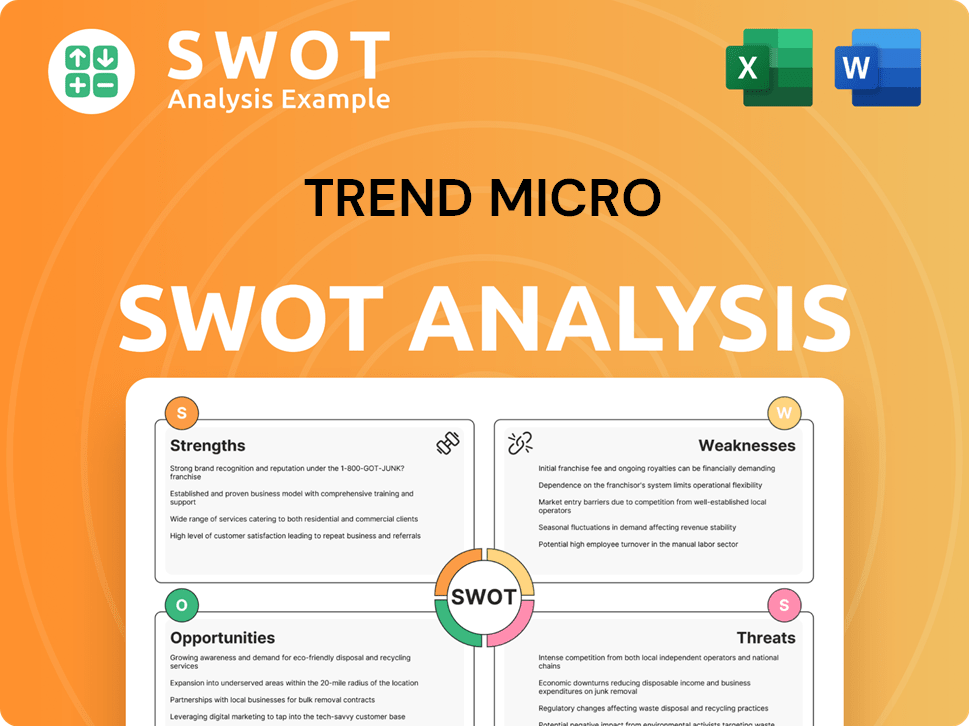
How Does Trend Micro Invest in Innovation?
The company's growth strategy is heavily reliant on technological innovation and its ability to anticipate and address evolving cybersecurity threats. This proactive approach is crucial in a market where the sophistication and frequency of cyberattacks are constantly increasing. The ability to offer comprehensive and integrated IT security solutions is central to its business model.
The company's focus on AI and platform-based security solutions is a key driver of its future prospects. By leveraging AI to enhance its threat detection and response capabilities, the company aims to stay ahead of emerging threats and maintain its competitive edge. The company's commitment to research and development, including a global presence across multiple locations, underscores its dedication to innovation and its long-term growth strategy.
The company's strategic initiatives are designed to meet the growing demand for robust cybersecurity solutions, particularly in the cloud computing sector. The company's ability to adapt and integrate cutting-edge technologies like AI, machine learning, and IoT into its product offerings positions it well for continued growth in the cybersecurity market. This focus is reflected in its financial performance and market share analysis.
The company leverages AI extensively to enhance its cybersecurity solutions. The AI-powered platform, Trend Vision One Cyber Risk Exposure Management, identifies risks and prioritizes mitigations. This proactive approach is critical for preventing attacks and ensuring business continuity.
The company has experienced significant growth in its next-gen AI Security Operations Center (SOC) services. The Annual Recurring Revenue (ARR) for this segment grew by 21% year-over-year in 2024, surpassing $273 million.
The company has a globally dispersed R&D presence, with 16 locations worldwide. This extensive network supports in-house development and allows the company to stay ahead of evolving cyber threats. The company's investments in research and development are crucial for its long-term growth.
The company actively integrates cutting-edge technologies like AI, machine learning, and IoT into its solutions. The industry-first security Large Language Model (LLM) Trend Cybertron is designed to empower network defenders. This integration enhances the effectiveness of its IT security solutions.
The company focuses on digital transformation and automation by consolidating tools and providing better visibility for enterprises. Over ten thousand customers are now leveraging its enterprise platform. This strategy improves efficiency and customer satisfaction.
The company continuously innovates, as demonstrated by new products and technical capabilities. Apex One Endpoint Security, launched in 2018, and the joint venture TXOne Networks with Moxa Inc. focusing on Industrial IoT security, are examples of this. The company's cybersecurity product offerings are constantly evolving.
The company holds a significant patent portfolio, with 1064 patents globally, highlighting its leadership in innovation. The company's forward-looking approach includes addressing emerging AI threats, such as AI-assisted deepfake phishing, virtual kidnapping scams, and automated reconnaissance, as outlined in its 2025 predictions report.
- The company's strategic initiatives are designed to meet the growing demand for robust cybersecurity solutions.
- The company's ability to adapt and integrate cutting-edge technologies positions it well for continued growth in the cybersecurity market.
- The company's focus on cloud security strategy and endpoint security solutions is critical.
- The company's threat intelligence capabilities are enhanced by its partnerships and collaborations.
Trend Micro PESTLE Analysis
- Covers All 6 PESTLE Categories
- No Research Needed – Save Hours of Work
- Built by Experts, Trusted by Consultants
- Instant Download, Ready to Use
- 100% Editable, Fully Customizable
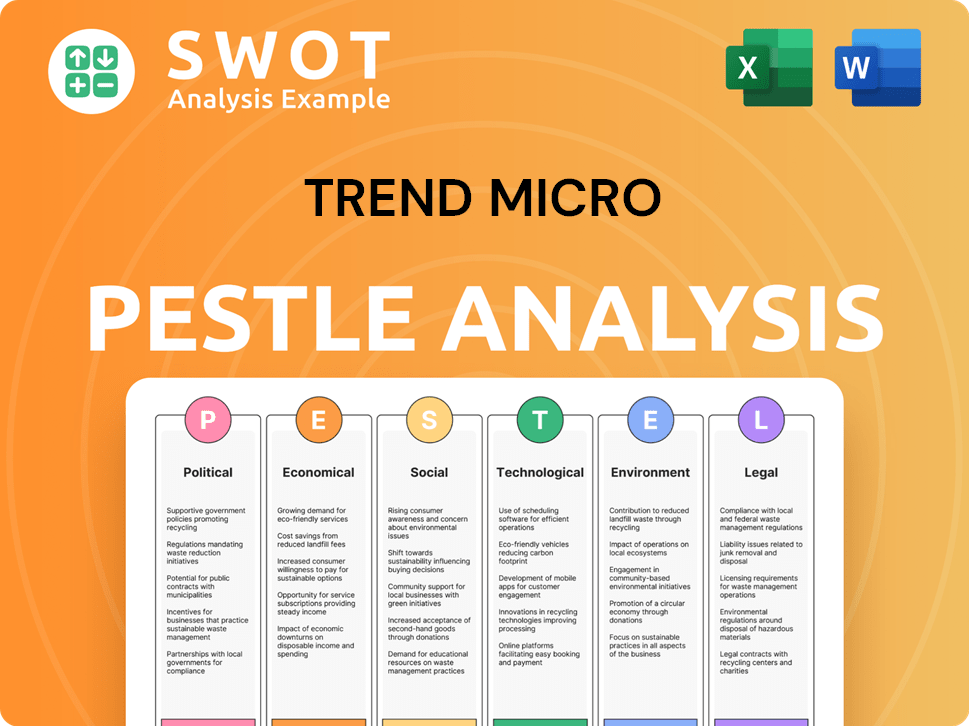
What Is Trend Micro’s Growth Forecast?
The financial outlook for Trend Micro reflects a strategic focus on profitable growth and market expansion within the dynamic cybersecurity market. Analyzing Trend Micro's financial performance provides valuable insights into its strategic direction and potential for future growth. The company's ability to adapt to market changes and maintain a strong financial position is crucial for its long-term success.
Trend Micro's financial results for early 2025 and its projections for the full fiscal year highlight its commitment to enhancing profitability and strategic transformation. The company's focus on innovation and customer satisfaction positions it well to capitalize on emerging opportunities within the cybersecurity sector. Understanding the financial dynamics of Trend Micro is essential for investors, analysts, and anyone interested in the cybersecurity industry.
For the first quarter of 2025, Trend Micro reported a total company Annual Recurring Revenue (ARR) exceeding $1.7 billion, demonstrating a 3% year-over-year increase. Consolidated net sales for Q1 2025 reached 67,501 million Yen (approximately $442 million USD), with an operating income of 15,006 million Yen (approximately $98 million USD), reflecting a 24% increase and a 22% operating margin. This financial data indicates the company's solid performance and ability to maintain profitability.
In fiscal year 2024, Trend Micro achieved global net sales of 272,638 million yen (approximately $1.8 billion USD), marking a 10% increase in actual currency. This growth underscores the company's strong market presence and effective strategies.
Operating income for 2024 rose significantly by 47.6% to 48,105 million yen, improving the operating margin to 18%. This improvement highlights the company's efficiency and strategic financial management.
Net income attributable to owners of the parent surged by 220.2% to 34,358 million yen in FY2024, reflecting a substantial increase in profitability. This growth demonstrates the effectiveness of the company's strategies.
Subscription revenues reached $784 million in 2024, constituting 62% of total revenue, indicating a shift towards a subscription-based business model, which is a key element of the Trend Micro growth strategy.
For the full fiscal year 2025, Trend Micro maintains its guidance, projecting consolidated net sales of 288,600 million Yen (approximately $1.87 billion USD) and an operating income of 60,300 million Yen (approximately $391 million USD). These projections reflect the company's confidence in its ability to sustain growth and profitability. The company is also targeting an 8% to 10% net sales growth by 2027 and aims for a 20% operating margin by the end of 2024, with long-term goals set on achieving 29-31% operating margins. While the transition to a subscription-based model has been a key focus, the decline in perpetual license renewals has impacted profitability, highlighting the need for continuous adaptation within the Trend Micro business model.
The company anticipates consolidated net sales of approximately $1.87 billion USD for fiscal year 2025. This projection demonstrates the company's confidence in its ability to maintain strong financial performance.
Trend Micro aims for an operating income of approximately $391 million USD in 2025. This target reflects the company's focus on enhancing profitability and operational efficiency.
The company is targeting an 8% to 10% net sales growth by 2027. This long-term goal showcases Trend Micro's commitment to sustained expansion within the cybersecurity market.
Trend Micro aims for a 20% operating margin by the end of 2024, with long-term goals of achieving 29-31% operating margins. These targets reflect the company's dedication to improving profitability.
The shift to a subscription-based model, with subscription revenues at $784 million in 2024, is a key element of the Trend Micro's strategic initiatives. The decline in perpetual license renewals has impacted profitability.
Trend Micro's strong financial performance and strategic initiatives position it well within the competitive cybersecurity market analysis. The company's focus on innovation and customer satisfaction is a key driver.
Trend Micro's financial performance in early 2025 and its projections for the full fiscal year demonstrate its commitment to growth and profitability. The company's focus on innovation and customer satisfaction positions it well to capitalize on emerging opportunities within the cybersecurity sector. For more insights, you can read a Brief History of Trend Micro.
- Total company ARR exceeding $1.7 billion in Q1 2025.
- Consolidated net sales of approximately $442 million USD in Q1 2025.
- Operating income of approximately $98 million USD in Q1 2025, with a 22% operating margin.
- Global net sales up 10% at actual currency in FY2024.
- Operating income saw a substantial rise of 47.6% in FY2024.
- Net income attributable to owners of the parent surged by 220.2% in FY2024.
Trend Micro Business Model Canvas
- Complete 9-Block Business Model Canvas
- Effortlessly Communicate Your Business Strategy
- Investor-Ready BMC Format
- 100% Editable and Customizable
- Clear and Structured Layout
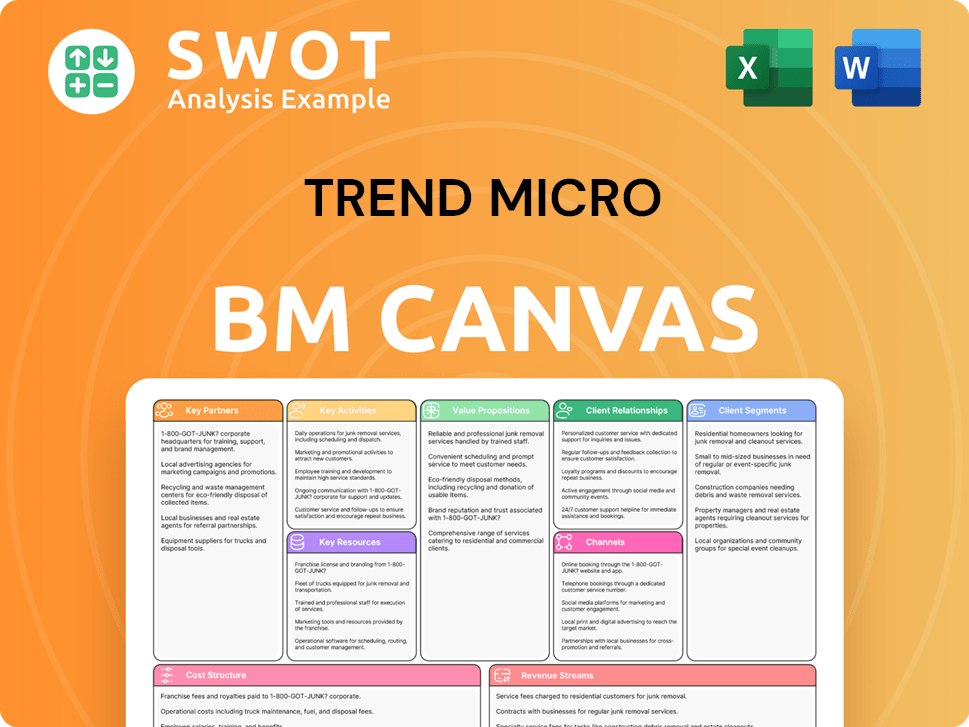
What Risks Could Slow Trend Micro’s Growth?
The cybersecurity landscape presents significant challenges for companies like Trend Micro, impacting its Trend Micro growth strategy and future prospects. Intense competition, technological disruptions, and evolving cyber threats create a complex environment. Understanding these risks is crucial for evaluating Trend Micro's future prospects and its ability to maintain a strong position in the market.
Trend Micro's company faces a dynamic set of obstacles. These include the need to adapt to rapid technological advancements, navigate regulatory changes, and manage internal operational challenges. Addressing these risks effectively is essential for sustaining growth and ensuring long-term success within the cybersecurity sector.
Several key areas pose potential risks and obstacles for Trend Micro. The cybersecurity market is highly competitive, with major players vying for market share. Technological advancements, particularly in areas like AI, are creating new threats and requiring continuous innovation. Additionally, regulatory changes and internal operational challenges can also affect the company's performance.
The cybersecurity market is fiercely competitive, with Trend Micro facing strong competition from major players. In the endpoint security space, where Trend Micro's growth strategy has been slower than market leaders, companies such as Microsoft, CrowdStrike, SentinelOne, and Palo Alto Networks are key competitors. The cloud-native application protection platform (CNAPP) market is also highly competitive, with rivals expected to surpass Trend Micro by the end of 2025.
Rapid technological advancements, especially in generative AI, are creating new cyber threats. These include AI-assisted deepfake phishing, virtual kidnapping scams, and automated reconnaissance. Cybercriminals are increasingly leveraging AI to automate and scale attacks, targeting AI systems themselves. Ransomware attacks continue to evolve, focusing on areas often overlooked by traditional endpoint detection tools.
Cyber threats are continuously evolving, posing a significant risk to cybersecurity firms. Supply chain vulnerabilities are a growing concern, with advanced persistent threat (APT) groups targeting cloud environments and supply chains. Vulnerabilities in public-facing servers, digital drivers, and software dependencies are increasingly exploited. These threats require constant vigilance and adaptation.
Regulatory changes, such as NIS2 and DORA in Europe, can influence market dynamics and require companies to adapt their security practices. Internally, challenges such as increased people costs due to a weaker yen have impacted operating income. Macroeconomic uncertainties have also affected enterprise sales, particularly in the U.S., with government-related transactions being paused or canceled. Technical issues with a third-party e-commerce platform have also impacted consumer sales.
While specific market share figures fluctuate, it's crucial to note that Trend Micro competes with large and well-established firms. The endpoint security market is saturated, and the cloud security space is rapidly evolving. The competition is intense, and maintaining or increasing market share requires continuous innovation and strategic adjustments. For more insights into the company's ownership structure, consider reading Owners & Shareholders of Trend Micro.
Macroeconomic factors, such as currency fluctuations and economic downturns, can significantly impact Trend Micro's financial performance. These factors can affect sales, operational costs, and overall profitability. The company must navigate these economic uncertainties to maintain financial stability and achieve its growth objectives. In 2024, these factors will continue to play a critical role.
To mitigate these risks, Trend Micro emphasizes a proactive security approach. This includes optimizing security settings and leveraging both native and third-party data sources for a comprehensive view of the attack surface. The company also implements risk management frameworks, such as the Trend Vision One Cyber Risk Exposure Management platform. Furthermore, Trend Micro focuses on platform consolidation to simplify security management for customers.
Continuous innovation is critical for staying ahead of emerging threats. Trend Micro is committed to investing in research and development to address new challenges posed by advancements in AI and other technologies. This includes developing new products and services and enhancing existing solutions to provide robust protection against evolving cyber threats. Innovation is key to maintaining a competitive edge in the cybersecurity market.
Trend Micro Porter's Five Forces Analysis
- Covers All 5 Competitive Forces in Detail
- Structured for Consultants, Students, and Founders
- 100% Editable in Microsoft Word & Excel
- Instant Digital Download – Use Immediately
- Compatible with Mac & PC – Fully Unlocked
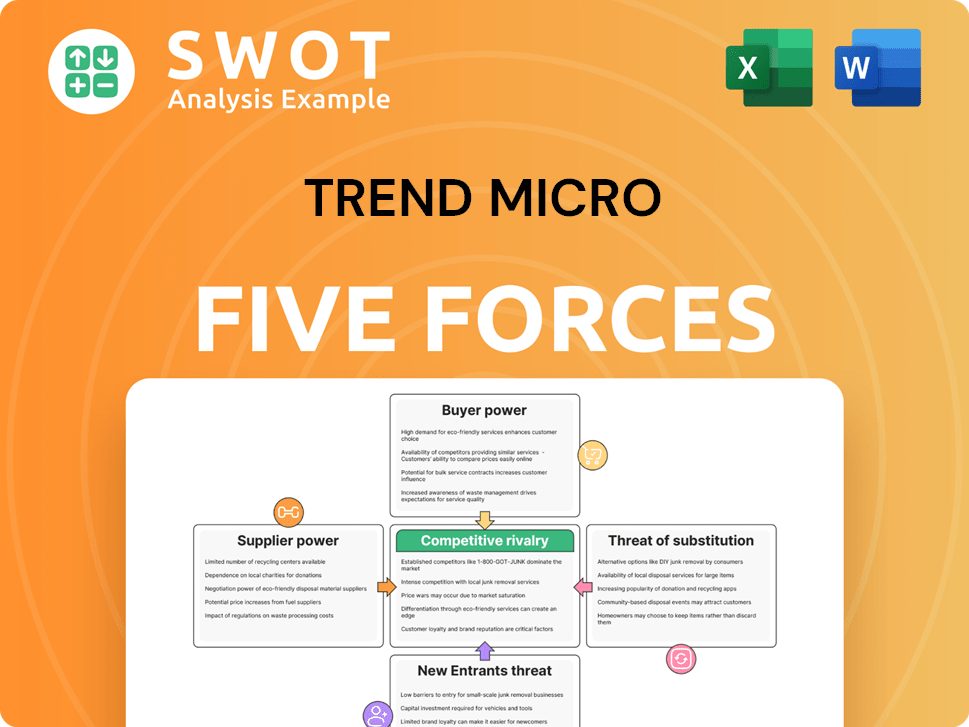
Related Blogs
- What are Mission Vision & Core Values of Trend Micro Company?
- What is Competitive Landscape of Trend Micro Company?
- How Does Trend Micro Company Work?
- What is Sales and Marketing Strategy of Trend Micro Company?
- What is Brief History of Trend Micro Company?
- Who Owns Trend Micro Company?
- What is Customer Demographics and Target Market of Trend Micro Company?
Disclaimer
All information, articles, and product details provided on this website are for general informational and educational purposes only. We do not claim any ownership over, nor do we intend to infringe upon, any trademarks, copyrights, logos, brand names, or other intellectual property mentioned or depicted on this site. Such intellectual property remains the property of its respective owners, and any references here are made solely for identification or informational purposes, without implying any affiliation, endorsement, or partnership.
We make no representations or warranties, express or implied, regarding the accuracy, completeness, or suitability of any content or products presented. Nothing on this website should be construed as legal, tax, investment, financial, medical, or other professional advice. In addition, no part of this site—including articles or product references—constitutes a solicitation, recommendation, endorsement, advertisement, or offer to buy or sell any securities, franchises, or other financial instruments, particularly in jurisdictions where such activity would be unlawful.
All content is of a general nature and may not address the specific circumstances of any individual or entity. It is not a substitute for professional advice or services. Any actions you take based on the information provided here are strictly at your own risk. You accept full responsibility for any decisions or outcomes arising from your use of this website and agree to release us from any liability in connection with your use of, or reliance upon, the content or products found herein.